While in the BOM editing mode, the properties dialog box of the BOM being edited can be called using the option:
![]() BOM properties
BOM properties
This option is located on the main toolbar (button set “BOM”).
The BOM properties dialog box can also be called by different means. For example, it can be accessed from the dialog box of the command "BM: Bills of Materials". Alternatively, in the command – waiting mode, move the pointer over one of the current BOM records and right click ![]() , and then in the coming up context menu select the item "BOM Properties". If this item is not available in the context menu, then first select the element "BOM" by using the item "Other".
, and then in the coming up context menu select the item "BOM Properties". If this item is not available in the context menu, then first select the element "BOM" by using the item "Other".
As the result of all these steps, the dialog box "BOM Properties" will appear on the screen. The dialog title bar will be displaying the name of the BOM that owns the properties.
"BOM" tab
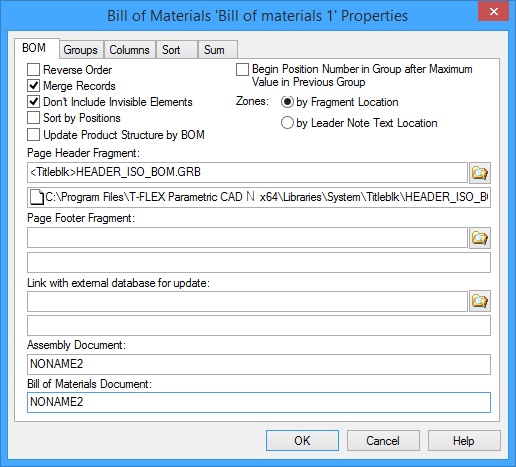
Merge Records. Allows merging BOM lines with identical records.
Example: suppose, the same fragment is inserted into assembly several times. In this case, the data are compared, and since there is no difference, the records of these fragments are merged in one row, as directed by the flag.
Reverse Order. With this flag set, the records in the BOM table will be coming in the reverse order, that is starting with the row with the highest ID number. The order of records in the table is defined by the sorting rules (see below).

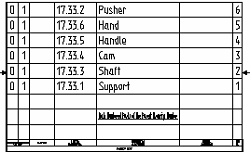
Don't Include Invisible Elements. When this flag is on, BOM will contain only visible fragments. Fragments invisible on the drawing (e.g. hidden with levels) will not be added to BOM.
Sort by Position. If BOM contains explicitly defined positions, when this flag is set, records in BOM tables will be sorted according to those positions along with the usual sorting rules.
Begin position number in group after maximum value in previous group. Setting of this flag will bring the following behavior: if any BOM group contains explicit positions with numbers greater than assigned automatically, numbering in the next group will begin from the values following the maximum explicitly specified number.
Zones. This parameter defines the zones when using the automatic zone definition mode (see the section "Preparing data for BOM table"). Takes the following values:
By Fragment Location. The zones will be defined by the fragment location.
By Leader Note Text Location. The zones will be defined by the location of the leader note that marks the fragment position.
The following two parameters define the name of the document containing the table header image, used in the prototype file:
Page Header Fragment. This parameter entry specifies the path to the file containing the BOM table header. (The case of using the header).
Page Footer Fragment. (The case of using the footer).
Link with external database for update. This parameter is used for connecting with a BOM based on an external database. Data exchange between the BOM and the database occurs only upon updating the BOM.
The parameters "Assembly Document" and "Bill of Materials Document" specify the path to the file or files containing the assembly and the BOM documents.
"Sections" tab
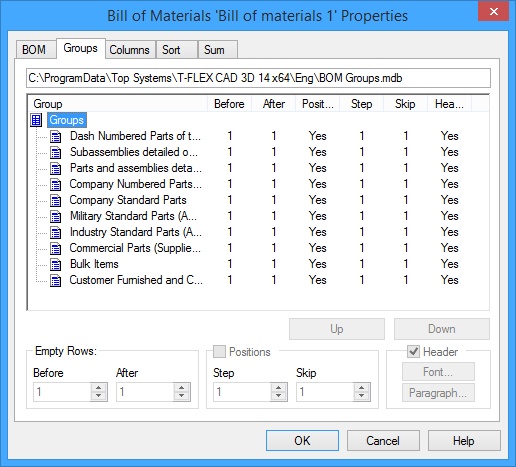
A box in the upper portion of this tab displays the path to the active groups database. This tab contains a table with the list of groups displayed as a tree, in its first column, and the rest of the columns displaying the parameters of the respective groups. The set of groups can be modified in the command "BG: Edit BOM Sections". The order, in which the groups are listed in this table, will be maintained as the groups are inserted in a BOM. For example, in the case represented by the above table, the group "Military standard parts" upon inserting in a BOM will be located after the groups "Company standard parts", and before the group "Industry standard parts". The existing group order can be changed using the graphic buttons [Up] and [Down].
To modify group parameters, select this group in the list. The parameters of the active group will appear in the entries in the lower portion of the tab. You can input the desired values of the following parameters:
Empty Rows: Before and After. Define the number of empty lines before and after the group header. These lines serve as separators, not allowing entering records.
Positions: Controls the group positions appearance. With this parameter set, positions will be set. If the parameter unset, this group will be ignored when setting the positions.
Step. Defines the step of setting the positions in the group.
Skip. Specifies the number of positions to skip for the beginning of the group. The number of the first position in the group will be equal to the number of the last position in the previous group plus the amount defined by this parameter.
Header. This parameter defines, whether the group header title is displayed in the BOM. The graphic button [Font] is used to call the dialog box for defining the font parameters of the group header title. The button [Paragraph] calls the respective dialog box for defining various parameters for group title formatting (see the chapter "Text").
"Columns" tab
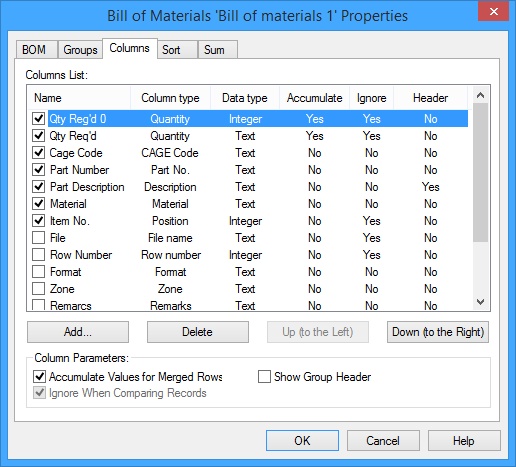
This tab contains the list of columns and their respective parameters. The columns are inserted in the BOM table, that are checkmarked in the box before the column name. The top-down order of columns in the list defines the column position in the BOM (left to right). A column position can be modified using the buttons [Up (to the Left)] and [Down (to the Right)]. Remember, however, that changing a column position will not affect the position of the respective column in the BOM table template, nor change its width.
The correspondence between the fragment data and the standard BOM table columns is defined by the type of the column, rather than its name.
The following are the only parameters of the current column allowed for modifications: "Accumulate Values for Merged Rows", "Ignore When Comparing Records", "Show Group Header".
When inserting the same fragment several times into the assembly, its data are compared, and, since identical, entered into the BOM as one record (in the case when the parameter "Merge Records" is set on the tab "BOM"). In this case, it is necessary that the records be summed up in the column "Quantity". This behavior is supported by the following two parameters.
Accumulate Values for Merged Rows. With this parameter set, the numerical figures will be summed up when merging the positions.
Ignore When Comparing Records. With this parameter set, the columns will be excluded from comparison (that is considered equal). If the parameter "Accumulate Values for Merged Rows" is set, then this parameter is also set automatically.
Show Group Header. The column with this parameter defined will display the group header.
In text of the united records with flags “Accumulate Values for Merged Rows” and “Ignore When Comparing Records” it is not possible to use variables that change their values depending on the assembly parameters. Such variables will be replaced with constants on uniting.
The list of columns can be modified using the graphic buttons [Add…] and [Delete…].
The graphic button [Add…] is used for creating a new column. It brings up a dialog box for defining all necessary parameters for the column being created.
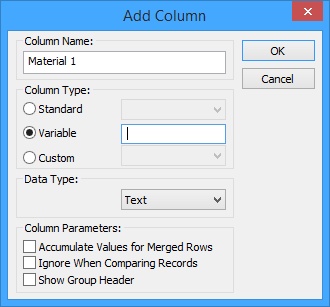
Column Name. This entry is for specifying the column name.
Column Type. Defines what fragment data will be entered in the column being created.
Standard. Presents the standard BOM data. The entries are copied from the respective section of the fragment BOM data. The data entry name for the BOM is selected from the combo box on the right hand side. By default, the column name coincides with the name of the selected entry. If necessary, the user can define an arbitrary column name. The BOM table can include two columns with the same standard BOM entry (for example, one can have a column presenting the weight of one part, and another column presenting the combined weight of several parts). If the list of columns contains records with coinciding entry names, the system of box a warning message.
Variable. Such a column will be displaying the value of the fragment variable. The variable name is entered in the box on the right hand side. The default column name will be the string "Variable
'variable_name'", however, if necessary, the user can specify an arbitrary column name. Only those boxes in the column will be filled in, that correspond to the fragments with the namesake variables defined. If the variable data type mismatches the data type of the BOM column being defined, the system automatically converts the data types.
Custom. Selecting this parameter provides access to the list of names for additional BOM entries. The list displays only the names of the entries that are added to the installation package (the file "…\Program\BOM Custom Data.txt"). The names of the entries that were defined among the fragment data by the user independently (see the section "Preparing data for BOM table"), are not displayed in this list. The specify one of those, place the pointer over the parameter entry "Column Name" and enter its name.
If necessary, the file containing the list of additional BOM entries can be manually edited, with one's own data included in it. The thus defined entries will be displayed in the list of additional entries of the above-described parameter.
When entering an arbitrary column name, the are two possibilities:
- If the data was defined under the same name in the fragment documents, then the created column will contain the respective data from the fragments;
- If the user creates a column with a unique name, then its data has to be entered manually. To use this feature, select the column while in the BOM editing mode and clear the default option "Automatic Field".
The "Data Type" combo box offers one of the following values:
Integer. Integer numbers only.
Real. Real numbers only.
Text. Arbitrary textual information.
The delete a column, select it in the list and press the graphic button [Delete].
"Sort" tab
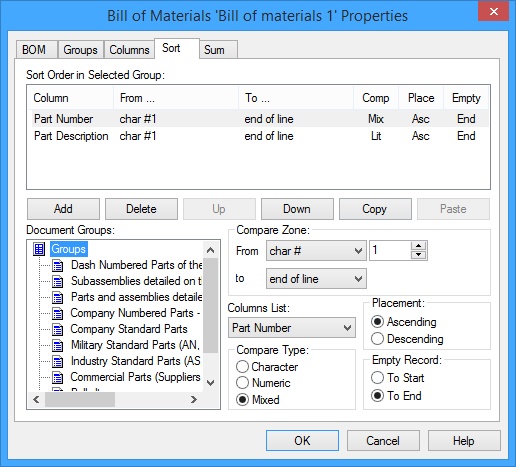
This tab is used for defining and editing the sorting rules for the BOM Records. By default, this tab reflects the sorting rules specified in the BOM prototype that was used for the BOM creation. The sorting rules are defined for each BOM group separately. Those appear as a set of conditions for comparing the contents of the selected BOM columns. The pane "Document Groups" defines the BOM group, for which the sorting rule is being defined or modified. The sorting defined for the group "Documents", affects the records that do not belong to any BOM group. The rule itself is displayed in the entry "Sort Order in Selected Group" in the form of a table, in which all the conditions are collected, that will be used for comparing lines in the group concerned. The order of applying the sorting conditions corresponds with their order in the table. If sorting rules are not defined for a group, then the records in the table will be placed in the order of the entering in the database.
The diagram shows that in the example the row comparison in the "Company Standard Parts" group will be done by two columns: "Part Number" and "Part Description". First, the lines will be compared in the column "Part Number", since this column appears first in the table. If several lines in this column will be identical, then their further comparison will be performed based on the records in the column "Description". The order of comparing the BOM lines by columns can be changed by altering the record positions in this table. This is done using the graphic buttons [Up], [Down].
To create or modify existing rules for sorting a group, do the following steps:
1. Select the desired group from the BOM group tree in the "Document Groups" pane. The list of columns with a currently defined set of sorting conditions will then be displayed in the "Sort Order in Selected Group" table.
2. Select the column whose sorting conditions are to be modified. The specified sorting condition settings will appear in the parameter fields on the right from the group list section.
3. Defines the required settings of the sorting parameters:
Columns List. Defines names of columns.
Compare Zone. Defines the excerpt of the table entry content to be used in comparison.
From. Defines the start of the excerpt to be compared.
Char # - the number of the character position (example: from the third character in the entry).
Substring – the number of a subsequent string occurrence in the entry (example: from the first occurrence of the string "ISO").
Char # from end – the number of the character position, counted from the end of line.
Substring from end - the number of the subsequent string occurrence in the entry, counted from the end of line (example: from the first occurrence of the string "ISO" from the end of line).
To. Defines the end of the excerpt to be compared.
Number of chars - defines the position number of the last character in the excerpt (example: until the character number 10 in the entry).
Substring - the number of the subsequent string occurrence in the entry (example: until the first occurrence of the string "-").
End of line – to the End of line.
Compare Type.
Character. Realizes comparison by ASCII characters (the contents of the two table entries are compared as two strings of characters). If the first character in the record entry is a number, the record is considered empty and is moved to the start or end of the group as prescribed by the parameter "Placement". If the several such records, their relative positioning will be random.
Numeric. Compares numbers (the contents of the two table entries are compared as two numbers). If the first character in the record entry is a letter, the entry is considered empty.
Mixed. If a non-numerical character appears on the first position of the first entry in the comparison, then the system identifies the substring of characters starting from the first position and compares it with the respective substring found in the second entry. If the second entry does not begin with a non-numerical character, then the first entry sub string is compared against the empty string. Next, the numerical substrings are identified, and the respective numerical values of the two entries are compared, starting from the first position after the last character string used in the previous step of the comparison. Thus, the contents of both entries are analyzed until reaching the end of the first entry. If a digit is found in the first position, the contents of the entry are considered an empty string of characters.
Placement. Defines the order of records placement. Case-sensitive.
Ascending. Begin with the first letter in the alphabet and the smallest number.
Descending. Last letters in the alphabet and largest numbers come first.
Empty Record. If empty lines exist in the group, intended for inputting records, this parameter will define whether these lines will be moved To Start or To End of the group.
To add a sorting condition in the table, first, unselect the existing records in the table. Next, set the necessary parameter values on the right of the list of groups, and press the [Add] graphic button. Alternatively, select one of the existing conditions in the table, then add it to the same table by the [Add] button and edit its settings.
The graphic button [Copy] allows copying one of several lines of the table with the sorting parameters defined to the clipboard, and then pasting them in another group. To select all lines, hold down the <Shift> key, several rows with the <Ctrl> key.
To delete one of the sorting conditions from the table, select this condition and press the graphic button [Delete].
With the "Automatic Update" ![]() mode set, the new records added the BOM table are instantly placed in the position defined by the specified sorting conditions (except the manually edit records).
mode set, the new records added the BOM table are instantly placed in the position defined by the specified sorting conditions (except the manually edit records).
"Sum" tab
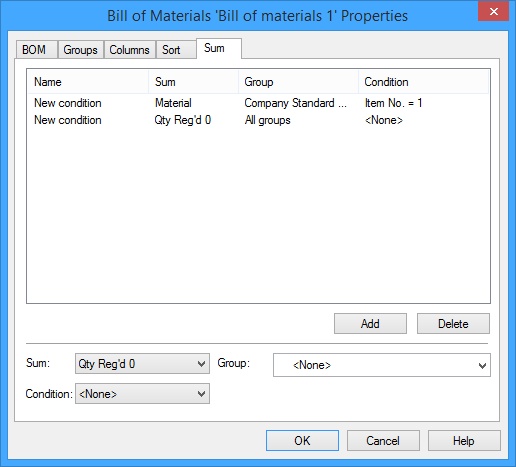
This tab is intended for defining the rules of summing up the data in BOM columns for evaluating the bottom line. A specified rule is not recorded in a database; rather, it becomes an attribute of the text and can be used in future for evaluating the bottom line of a BOM column. As an example, select the text used for creating some BOM table, and right click ![]() . From the coming up menu select the command "Measure…". The element with the name of the summing rule will be present in the list of the text attributes.
. From the coming up menu select the command "Measure…". The element with the name of the summing rule will be present in the list of the text attributes.
If necessary, you can create a variable with the value equal to the sum, calculated based on the specified rule.
To define a new rule for summing up a column, specify the following parameters:
Sum. Specify the target column of this summing rule.
Group. Specify the BOM group to apply this rule to. The "<None>" setting means the rule will be applied to all records in the table.
Condition. Defines limitations on the BOM table records to be included in the bottom line evaluation. Select a column, a comparison condition and a value to compare the entry against. Selecting "<None>" means the condition is applied to all records in the table.
To input the defined settings, press the graphic button [Add]. The new rule will appear among the list of rules, named by default "New condition", with the summing parameters defined. The graphic button [Delete] deletes the current record from the list of summing rules. To modify a whole name, point at the entry "Name" of the desired column and double-click ![]()
![]() . The rule name will then be focused on, so that you can edit it.
. The rule name will then be focused on, so that you can edit it.